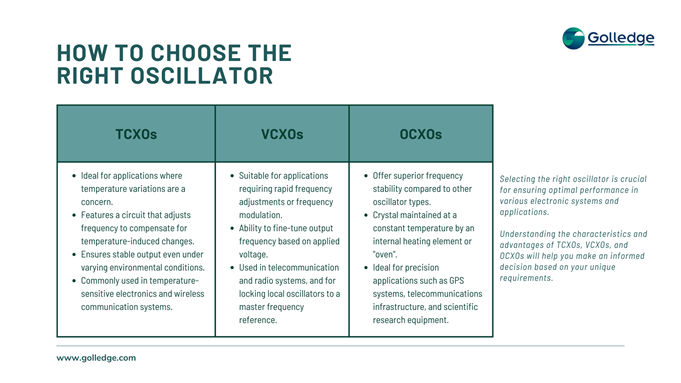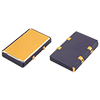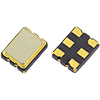Oscillators: An Overview of Their Role in Electronic Circuits
8 Jun 2023
KATIEJENKIN@GOLLEDGE.COM
Welcome to a comprehensive exploration of frequency control, the lifeblood of modern electronics.
In this guide, we will be focusing on one of the most influential frequency control products: The Crystal Oscillator.
Crystal oscillators are electronic circuits designed to generate an electrical signal of a precise frequency. This oscillator frequency is determined by the physical characteristics of a quartz crystal, which serves as the oscillator's resonant element.
This guide will look to further explain the basics of oscillators, the magic they spin in generating frequencies, and the critical role they play in electronic circuits. It is an ideal resource for electronics enthusiasts, budding engineering students, creative hobbyists, and anyone harbouring a keen interest in understanding the inner workings of electronic circuits.
If that sounds like you, then read below for a comprehensive overview on the role of oscillators and the impact they have on our modern, technological world.
The heartbeat of electronics: Oscillators
When it comes to the essence of electronic circuits, one word comes to mind: oscillators. But what exactly are these unseen heroes, and why do they hold such a significant position in the world of electronics?
Oscillators, at their core, are electronic devices that produce a continuous, repetitive waveform.
Think of them as the 'heartbeats' of electronic circuits, emitting pulses or signals at regular intervals. This pulsating beat is what we refer to as a 'frequency', and it's this frequency that governs everything from the transmission of a radio signal to the accurate rendering of time on your digital wristwatch.
Oscillators generate these frequencies by employing a principle of physics known as resonance, much like a pendulum swinging back and forth.
Depending on the type of oscillator, this resonant element could be anything from a quartz crystal to a specific arrangement of inductors and capacitors. The output is a steady and regular waveform that forms the basis for an endless array of electronic applications.
In our everyday lives, oscillators are the silent pillars that support a myriad of technologies that are so prevalent in our modern world. They ensure that our smartphones connect seamlessly to networks, they guide GPS satellites across the expanse of space, and guarantee precision in advanced medical and scientific equipment. Without oscillators, our interconnected, digital world would come to a standstill.
At Golledge Electronics, we understand the critical role oscillators play in the fabric of our technological society. This is why our commitment to quality and accuracy in our frequency control products is unwavering.
Each of our oscillator products is carefully designed and manufactured to generate stable, precise frequencies, ensuring the optimal operation of your electronic devices.
The variety and versatility of Oscillators
The world of oscillators is as diverse as it is fascinating. This diversity allows for a vast array of applications, each tailored to meet specific requirements of stability, accuracy, and environmental resilience.
Three types of oscillators that are particularly noteworthy are TCXOs, VCXOs, and OCXOs. Let's take a closer look at each.
TCXOs , or Temperature Compensated Crystal Oscillators, offer a significant advantage in applications where temperature variations are a concern.
These oscillators incorporate a circuit that adjusts the frequency property of the oscillator to compensate for temperature-induced changes, thus maintaining a stable output even under varying environmental conditions.
VCXOs , or Voltage Controlled Crystal Oscillators, provide the ability to fine-tune the output frequency based on an applied voltage.
This unique feature makes VCXOs ideal for applications requiring rapid frequency adjustments or frequency modulation, such as in certain telecommunication and radio systems, or locking local oscillators to a master frequency reference.
OCXOs , or Oven Controlled Crystal Oscillators, offer superior frequency stability.
In these oscillators, the crystal is maintained at a constant temperature by an internal heating element, often referred to as an "oven". This design allows OCXOs to deliver exceptionally stable frequencies, making them an excellent choice for precision applications such as GPS systems, telecommunications infrastructure, and scientific research equipment.

Other types of oscillators
Beyond the high-frequency oscillators discussed earlier, other oscillator types exist, each tailored to specific applications and frequency variations. Here are some additional oscillator types worth noting:
- Phase-Locked Loop (PLL) oscillators: PLL oscillators generate output signals synchronised to a reference input signal, offering precise frequency and phase control. They find extensive use in frequency synthesis, clock generation, and communication systems, providing stable and accurate frequency references.
- Ring oscillators: Ring oscillators consist of an odd number of inverting stages connected in a loop, producing an oscillating output signal. They are commonly used in integrated circuits for clock generation, frequency division, and delay line applications, offering simplicity and compactness.
- Relaxation oscillators: Relaxation oscillators utilise a feedback mechanism involving charging and discharging of a capacitor to generate periodic waveforms. They are often used in low-frequency applications such as timing circuits, pulse generators, and waveform synthesis.
- LC oscillators: LC oscillators rely on the resonance of an inductor-capacitor (LC) circuit to generate oscillations. They are commonly used in radio frequency (RF) and microwave applications, offering simplicity and cost-effectiveness.
- MEMS oscillators: Microelectromechanical systems (MEMS) oscillators integrate miniature mechanical resonators with electronic circuitry to generate oscillations. They offer advantages such as small size, low power consumption, and shock resistance, making them suitable for portable and battery-operated devices.
- Tunable oscillators: Tunable oscillators allow for the adjustment of the output frequency over a specified range. They find applications in frequency modulation (FM) radios, frequency synthesizers, and test and measurement equipment, offering flexibility and versatility.
What is oscillator used for?
Oscillators are fundamental components in electronic circuits, playing a pivotal role in generating repetitive waveforms essential for various applications. Let's list down some key oscillator applications in this section:
- Clock generation: Oscillators are commonly employed as clock generators in digital systems, providing precise timing signals to synchronise operations and facilitate data transmission. In microprocessors, for example, oscillators regulate the timing of instructions and ensure smooth execution of tasks.
- Signal generation: Oscillators produce stable and predictable waveforms across a wide range of frequencies, making them ideal for generating carrier signals in communication systems. From radio frequency (RF) transmitters to audio synthesizers, oscillators generate signals used for transmission, modulation, and demodulation.
- Frequency control: Oscillators play a crucial role in controlling the frequency of electronic devices. By adjusting the oscillation frequency, oscillators enable precise tuning of radios, televisions, and other communication equipment to specific channels or frequencies.
- Timing and synchronisation: In digital circuits, oscillators provide precise timing references for coordinating the operation of multiple components. They ensure accurate timing in applications such as data sampling, data conversion, and signal processing.
- Testing and measurement: Oscillators serve as reference sources for testing and calibration purposes in electronic equipment. They provide stable and reproducible waveforms for measuring parameters such as frequency, phase, and amplitude.
- Clock recovery: In data communication systems, oscillators are used for clock recovery, where they regenerate timing signals from incoming data streams. This ensures accurate data reception and synchronisation in high-speed communication links.
- Control systems: Oscillators are integral to the operation of control systems, where they generate signals for feedback and control. They enable precise regulation of parameters in systems such as motor speed controllers, temperature controllers, and voltage regulators.
The role of Quartz Crystals in Oscillators
When delving into the world of oscillators, it is imperative that we discuss the quartz crystal oscillator.
These special types of oscillators harness the power of quartz crystals to create a stable and accurate frequency reference, making them a staple in an immense array of electronic devices.
But why quartz, you might wonder?
Quartz, a crystalline form of silicon dioxide, possesses a remarkable property known as piezoelectricity. This means that when pressure is applied to a quartz crystal, it generates an electric charge, and vice versa. In a quartz crystal oscillator, an electric field causes the crystal to vibrate at its natural resonant frequency, generating a consistent and reliable signal.
The superiority of quartz lies in its unparalleled stability and minimal temperature coefficient. Even when exposed to fluctuating environmental conditions, a quartz crystal oscillator will maintain its frequency with remarkable consistency. This makes it an ideal choice for precision frequency applications where stability and accuracy are paramount.
At Golledge Electronics, we appreciate and harness the distinctive properties of quartz in our wide range of clock oscillator products. Selected for their highly competitive commercial pricing and wide range of developed frequencies and specifications, our quartz crystal oscillators offer excellent performance and value.
Design Considerations: How to choose the right oscillator
Choosing the right oscillator for your specific application is an essential part of the overall product design operation. It's an integral decision where several key factors come into play.
Here are some of the top considerations to keep in mind when deciding on the best type of oscillator for your product:
Frequency Range
The primary consideration is often the oscillator's frequency range.
The output frequency must be in alignment with the requirements of your device, whether it's a low-frequency application such as a digital clock or a high-frequency need such as a high-speed data communication system.
Stability
The stability of an oscillator under varying environmental conditions, such as temperature or humidity, is another critical factor.
As we've discovered, different types of oscillators like TCXOs and OCXOs offer varying degrees of stability to cater to these requirements. Make sure you choose one that is suitable for your applications expected environment.
Power Consumption
The energy efficiency of an oscillator is another essential aspect, particularly for battery-powered devices.
Lower power consumption not only prolongs battery life but also contributes to a greener, more sustainable electronic solution. Be sure to take the expected power consumption and battery life of your application into consideration when selection your type of oscillator.
Size and Cost
The physical size of the oscillator and the associated cost can also influence oscillator choice, particularly in compact, consumer-focused electronic devices where both space and cost are at a premium.
If you’re designing a small-sized piece of technology, you’ll need a small, compact oscillator to match.
How Golledge can help
Choosing the right oscillator might seem a daunting task, but it's here that Golledge Electronics steps in, turning complexity into simplicity.
Our customer-focused approach means we take the time to understand your specific requirements, guiding you through the selection process to find an oscillator that aligns perfectly with your needs.
Our wide range of high-quality oscillators ensures we can meet the diverse demands of any application, whether it requires a TCXO's temperature resilience, a VCXO's adjustable convenience, or an OCXO's ultimate stability.
Ultimately, the right oscillator can make all the difference in the successful operation of your electronic device. At Golledge Electronics, our commitment to our customers, coupled with our expert knowledge of frequency control products, ensures we're always ready to help you make that perfect choice.
Contact our expert team today to discuss your project needs further. We’d be more than happy to help.




